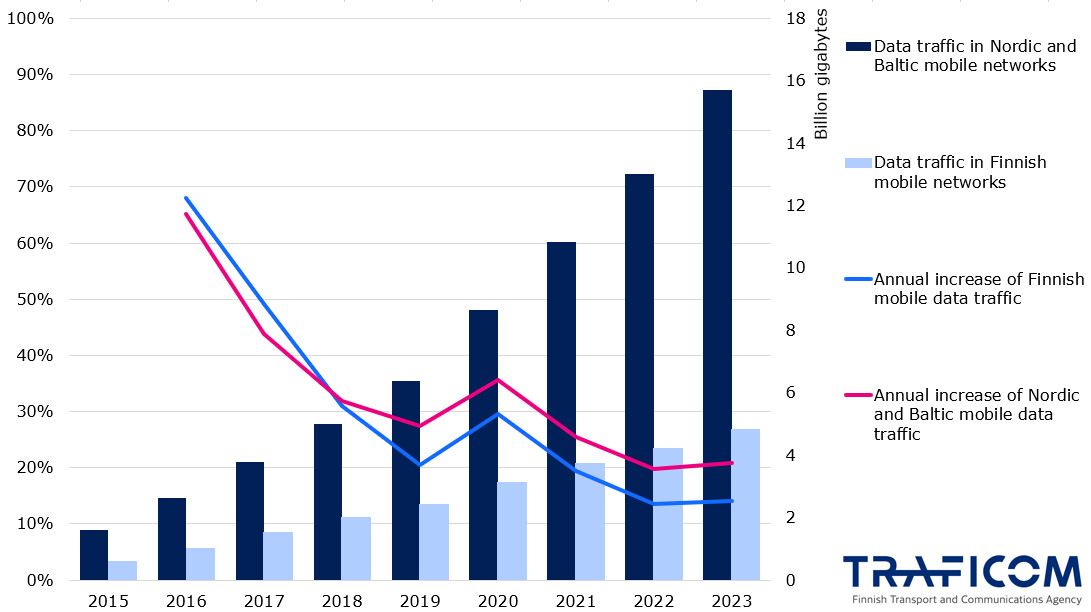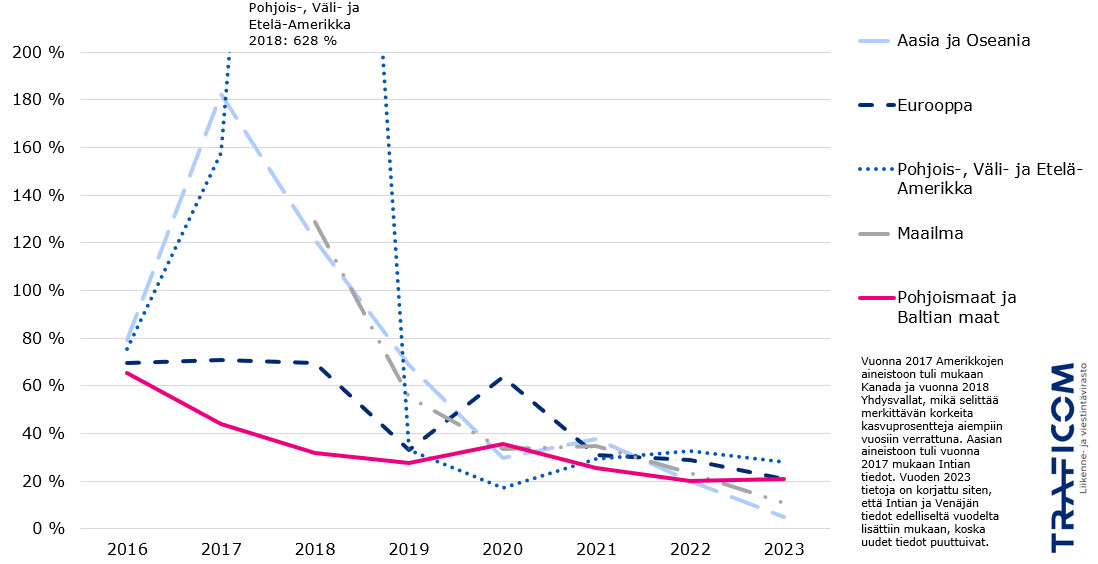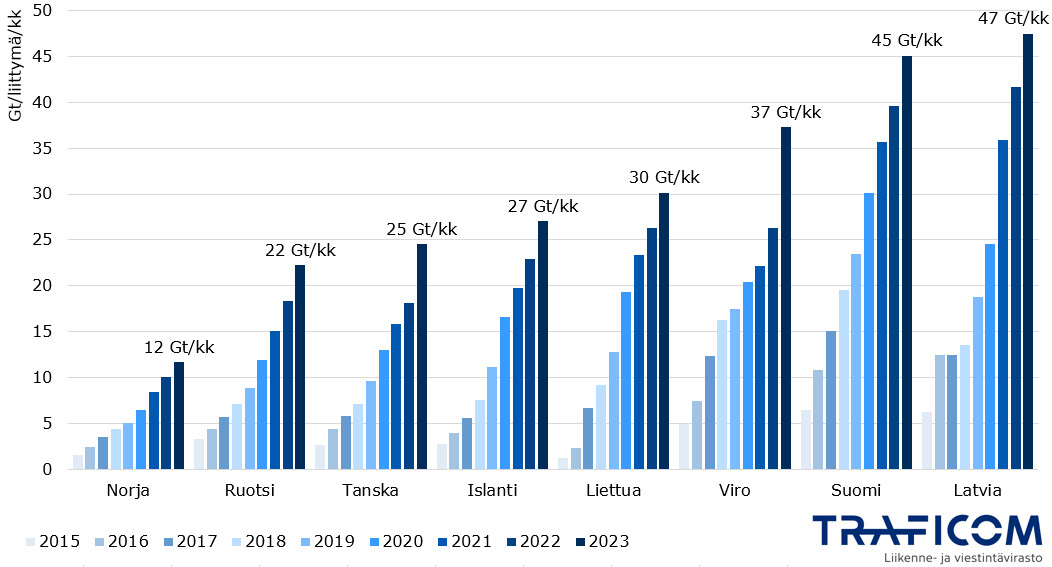The volume of data transferred in mobile networks has continued to grow, but for example in the Nordic and Baltic countries, the growth rate has slowed down from the annual growth of 65% during the peak years to the current annual growth of 21%. Of the Nordic and Baltic countries, the largest volume of mobile data transfer per connection was used in Latvia. In Finland, connections were used for data transfer almost equally actively and Finland had the highest amount of data transfer per inhabitant.
Year by year, an increasing amount of data is transferred in mobile networks in the Nordic and Baltic countries. In 2023, mobile data transfer already amounted to almost 16 billion gigabytes according to the statistics compiled by the telecommunications authorities of these countries. This means that the volume of data transfer used by an inhabitant in the Nordic and Baltic countries was on average 38 gigabytes per month.
The increase in the volume of data transmitted in mobile networks has slowed down
Although the volume of mobile data transfer grows on an annual basis, its growth has slowed down significantly over the past 10 years. In 2016, the volume of mobile data transfer increased by 65% in relation to the volume of data transfer the previous year, but the increase had fallen to only 21% by 2023. There are differences between the countries: the absolute volume of mobile data transfer grew most, by 36%, in Denmark. In Estonia, Lithuania, Iceland and Sweden, data transfer increased by more than 20%, whereas in Latvia, Norway and Finland, the increase was less than 20%. The increase was the most moderate in Finland – only 14%. However, the building of 5G networks does not seem to have increased the volume of mobile data transfer compared to the general trend in any of the countries.
“In Finland, the volume of mobile data transfer increased by up to 93% in 2015 compared with the preceding year. The increase peaked when more and more people changed over to using smartphones and 4G networks developed and expanded,” says Senior Specialist Marja Heinonen. “Although the number of applications and services has been growing constantly and improvements such as better image quality increases data transfer, usage is no longer increasing to the same extent as when new users flooded to the networks,” Heinonen continues.

The trend in Finland follows the global direction
The volume of data transferred in mobile networks is also increasing globally, but the growth rate has slowed down. Based on the statistics of the International Telecommunication Union (ITU), the global growth was about 10% in 2023. In 2023, countries in Asia and Oceania accounted for 63% of the global data transfer in mobile networks, while North, Central and South America accounted for 14% and Europe for 11%. The Nordic and Baltic countries accounted for 13% of the mobile data transfer in Europe.
There are great differences between regions in how comprehensive the coverage of the fastest mobile networks is and how the mobile network is used in general. “In Finland, many households use the mobile network as the home internet, whereas in many other European countries, the mobile network is mainly used only on mobile devices outside the home,” specifies Heinonen.

The largest amount of mobile data per connection was transferred in Latvia
According to the comparison of the Nordic and Baltic countries, the largest amount of mobile data per connection in 2023, 47 gigabytes per month, was transferred in Latvia. Finland came a close second (45 gigabytes per month). Until the beginning of the 2020s, Finland held the first place in the use of mobile data for a long time, but the volume of mobile data transfer has later increased significantly in Latvia and Estonia.
In international comparisons, the Nordic and Baltic countries are almost all among the countries with larger volumes of mobile data transfer. Based on ITU's statistics, the countries with the highest use of mobile data transfer per connection globally are Kuwait, Latvia, Saudi-Arabia, Finland and Taiwan. For example, the volume of mobile data transfer in France was 15 gigabytes per connection per month, in China 14 gigabytes and in the United States 13 gigabytes.

When calculated per inhabitant, Finland still holds a clear first place in the Nordic-Baltic comparison. In 2023, 72 gigabytes of mobile data per month were transferred per inhabitant in Finland. Latvia came next with the monthly data transfer of 58 gigabytes per inhabitant and then Estonia with the volume of 53 gigabytes per inhabitant.
There are slight differences in the volumes of data transferred in mobile networks that the Nordic and Baltic countries have recorded in their statistics depending on whether mobile connections used in fixed locations, that is connections implemented with 4G/5G modems in homes, are included in the statistics. For example, in Finland, the volume of data transfer includes all home broadband connections apart from those for which a quality promise similar to connections in a fixed network has been given, whereas in Norway, the mobile broadband connections of homes are not included in the volume of mobile data transfer at all.
In addition to the volume of data transferred in mobile networks and the number of connections, the telecommunications statistics of the Nordic and Baltic countries include statistics on the availability of fixed network broadband connections and services and on the revenues and investments related to telecommunications activities.